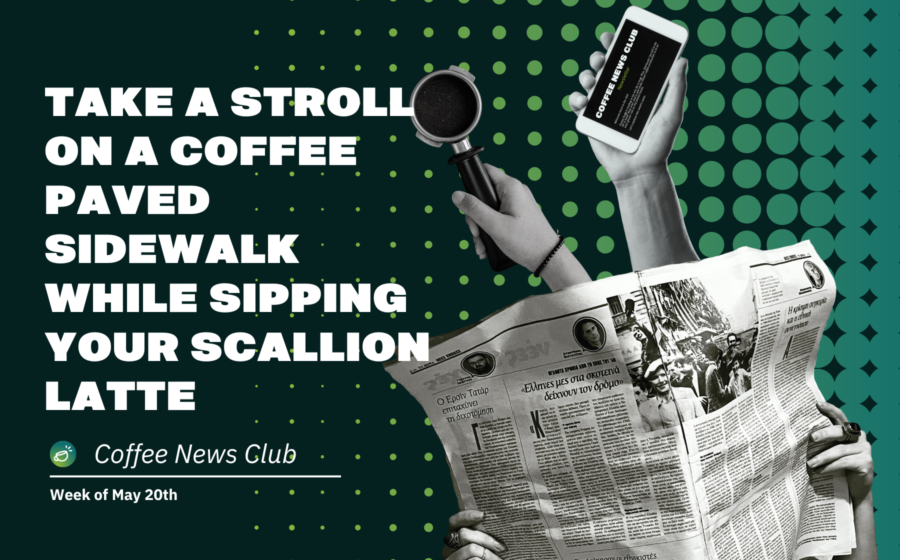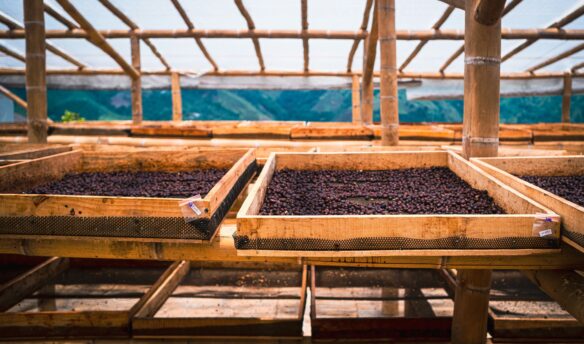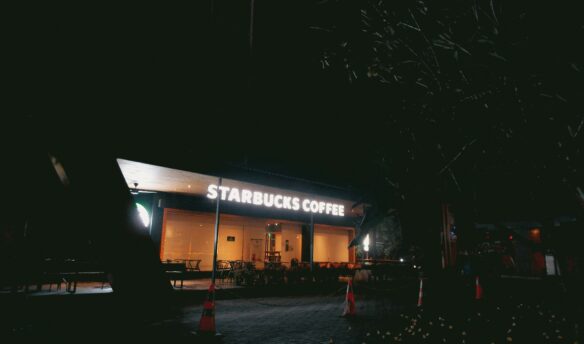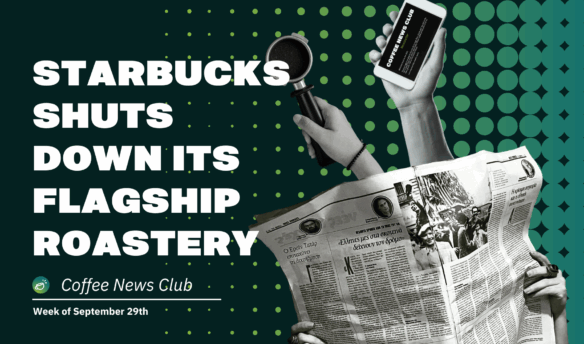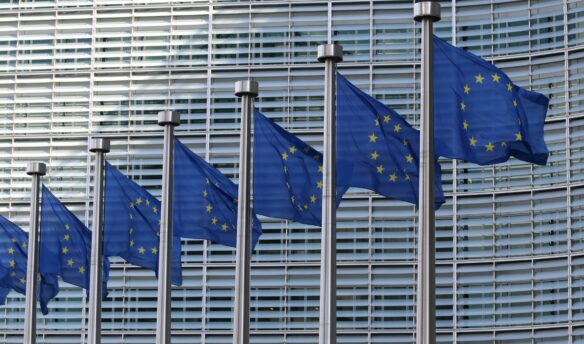Who wants scallions in their latte? Plus, Americans today drink less coffee than their grandparents, and in Australia, take a jaunt on a pathway made with coffee concrete.
‘Americans Are Drinking Half the Coffee They Did in the 40s’ – via the Guardian
In April, the National Coffee Association published its latest National Data Trends report, which found that daily coffee consumption is at a two-decade high. But this week, The Guardian, citing research from the US Department of Agriculture, reported that coffee consumption peaked in 1946 and has been falling ever since. So, who is correct?
Perhaps both reports are. The USDA research cited by The Guardian was published in 2007 and its data stops in 2005. As Sprudge points out, this is when the NCA reports that consumption skyrocketed. Another complicating fact is how both studies measured consumption: the NCA looked at the number of Americans who consumed coffee in the past day, whereas the USDA looked at volume.
And what volume! In 1946, the average American drank 46.4 gallons of coffee yearly, almost double the average in 2005. Researchers theorize that people began drinking less coffee because of carbonated soft drinks, which began to rise in popularity in the 1940s and overtook coffee in the mid-1970s.
Some coffee professionals took to LinkedIn to speculate about the drop-off, with folks guessing that people are drinking less because, well, coffee tastes better now. While drinking an entire pot of relatively weak coffee might previously have been the norm, today, we consume well-brewed, high-quality coffee in smaller amounts, the theory goes.
The rise of espresso-based drinks has also likely influenced consumption volumes. Espresso-based drinks are more concentrated coffee beverages, meaning people might drink less coffee by volume (even though they’re getting the same caffeine buzz). Single-dose pod-based machines could also account for the fall in volume consumed.
Sprudge crunched the numbers to determine what NCA’s data (measuring consumption by cups of coffee consumed) equals by volume. They found that, with 517 million cups consumed daily at eight ounces per cup, Americans drink 35.38 gallons of coffee per person annually.
So yes, technically, Americans drink less coffee than their parents and grandparents did in 1946, but NCA’s data indicates that consumption has been going up over the past few years and may soon return to those peaks.
‘World’s First Coffee Concrete Footpath Trialed in Australia’ – via Interesting Engineering
In 2023, we reported on researchers mixing coffee grounds into concrete to reduce the amount of sand used. But now, builders in Australia are using coffee concrete to make actual, usable structures. You can walk on coffee grounds!
Sand is an integral part of concrete manufacturing, and there’s currently a global shortage, not to mention the environmental issues of dredging beaches and rivers to cope with demand. So swapping some of that sand with coffee grounds—a lot of which ends up in landfill—is a win-win. And as a bonus, it turns out that coffee concrete is stronger than regular concrete.
To create the concrete, researchers at the Royal Melbourne Institute of Technology (RMIT) used pyrolysis, which involved heating waste coffee grounds to about 350°C (662°F) in an oxygen-deprived environment, to create biochar. The biochar was added to the concrete mix, replacing up to 15% of the required sand.
Initially, researchers were simply experimenting with how coffee grounds could be used in concrete to replace sand. But this past month, members of the Macedon Ranges Shire Council built a footpath in Gisborne, a town in southwestern Australia, using coffee concrete.
“We’re taking those experiments and putting them in ground and in the field today,” said Shane Walden, a Macedon Ranges Shire Council member, in a press release. The organization plans to test how the footpath stands up to use and if coffee concrete is a viable building material for future use.
The researchers also hope that coffee concrete, because of its sturdiness, can reduce the amount of concrete needed for building projects. Attention now turns to finding other commercial opportunities: “We are currently working in the supply chain sector so that we can make this research into a mainstream product for commercial applications,” said Dr. Rajeev Roychand from RMIT.
‘A Scallion Latte Is The Latest Viral Trend In China’s Dark Cuisine’ – via Sprudge
Would you drink an iced spring onion latte? If you’ve scrolled through social media recently, you’ve likely seen creators in China combining alliums and caffeine, part of a trend of coffee drink experimentation. Dubbed “dark cuisine,” according to the Singaporean website Must Share News, the trend involves combining unlikely food items to “challenge conventional notions of what is considered appealing food.”
Other dark cuisine coffee concoctions include oyster coffee, beef broth lattes, coffee-infused rice, and soy sauce lattes.
The scallion latte involves a thick layer of chopped spring onions, ice, milk, espresso, and an onion garnish on top. Feel free to experiment at home—or, for those who would like to experience the drink without actually having to taste it, 2022 US Barista Champion Morgan Eckroth has a video on YouTube where she makes her own.
More News
‘Cup of Excellence Mexico Celebrates Record Breaking Competition‘ – via Global Coffee Report
‘Used Coffee Grounds Could Be A Big Part Of Next-Generation Batteries’ – via Sprudge
‘Coffee Traders Speed Up Shipments Before EU Deforestation Law, Says ICO’ – via Reuters
‘Costa Rica Coffee Report: Production Near Record Lows’ – via Daily Coffee News
‘Volcafe Receives $60 Million in Funding for Trade Finance Facility’ – via Global Coffee Report
‘Black Farmers in Brazil Changing Views on Coffee Production‘ – via France 24
‘El Salvador Coffee Report: Migration and Farm Abandonment On the Rise’ – via Daily Coffee News
‘The 2025 World Barista Championship Is Heading Back To Milan, Italy’ – via Sprudge
Is Coffee Good For You?
According to a new study from the Netherlands, coffee drinkers had a lower risk of developing Parkinson’s disease than non-drinkers. Researchers have looked at the link between the two before, with studies generally showing that coffee (and caffeine) can help reduce the risk of developing the disease, although some have proven the opposite.
However, this new study, published in Neurology and carried out by researchers from the University of Utrecht, examined participants in the European Prospective Investigation into Cancer and Nutrition (EPIC) cohort study. Researchers narrowed in on 184,024 people from across the continent to see if coffee drinking had any impact on developing Parkinson’s.
Of the 184,024 participants, 93% reported drinking coffee. Of that group, the 25% who reported drinking the most coffee were 40% less likely to develop Parkinson’s than those who didn’t drink coffee at all.
“This study demonstrated an inverse association of caffeinated coffee consumption with the risk of PD [Parkinson’s disease] in one of the largest longitudinal cohorts worldwide with more than 20 years of follow-up”, the authors wrote. “The neuroprotective effects of coffee were exposure dependent, and individuals in the highest coffee consumption group had nearly 40% lower risk of PD compared with non-consumers.”
Beyond the Headlines
‘How Did Starbucks’ Fall From Grace?” by Joel Mathis
‘Coffee’s Tech Dystopia’ by Fionn Pooler
‘What Does Experimental Processing Mean for Farmers?’ by Veronica Blaine



